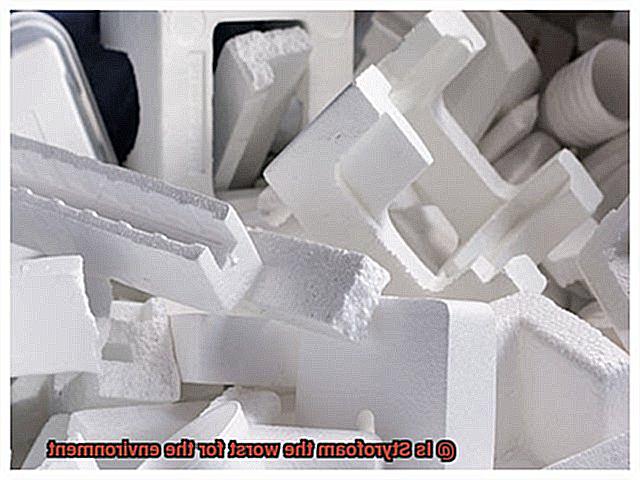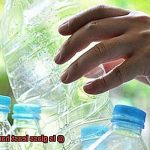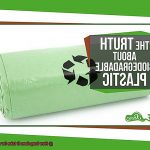For years, Styrofoam has been a staple in our daily lives. It’s lightweight, durable, and cheap – making it the ideal choice for packaging, insulation, and even disposable dishes. But what happens to it once we’re done with it? Are we unknowingly contributing to irreversible damage to the environment? It’s time to face the facts and take a closer look at one of the worst environmental hazards facing us today.
Styrofoam, also known as Expanded Polystyrene (EPS), is a type of plastic that doesn’t biodegrade – meaning it can take hundreds of years to break down, if ever. But that’s not all. Styrofoam is a major source of plastic pollution that has been wreaking havoc on aquatic life for years. And let’s not forget about its contribution to global warming – Styrofoam manufacturing releases harmful greenhouse gases into the atmosphere.
But as consumers, we have the power to make a difference by choosing eco-friendly alternatives. However, with Styrofoam seemingly everywhere – from coffee cups to shipping materials – it can be challenging to know where to start. That’s why in this blog post, we’ll dive deep into the facts about Styrofoam and its impact on our planet. So sit back with your favorite brew and read on to find out whether Styrofoam really is the worst offender when it comes to harming our environment – and learn what you can do to help create positive change.
What is Styrofoam?
Contents
Styrofoam is a lightweight, versatile, and affordable material that has found its way into various industries, including packaging, insulation, and food service. However, the process of creating Styrofoam is not as harmless as it seems.
Styrofoam is made from polystyrene, a petroleum-based plastic that is heated and expanded with steam to create a foam that can be molded into various shapes and sizes. While it provides excellent insulation and cushioning properties, it is not biodegradable and can take hundreds of years to break down in the environment.
The persistence of Styrofoam waste poses a severe threat to wildlife and ecosystems, as it releases harmful chemicals that can cause adverse effects on the environment. Moreover, the production of Styrofoam requires large amounts of fossil fuels and produces toxic waste products that can be hazardous to workers and nearby communities.
Although recycling programs for Styrofoam exist, they are costly and inefficient. Even when Styrofoam is recycled, it can only be repurposed into lower-grade products like park benches or insulation. Proper disposal of Styrofoam in landfills or recycling centers that accept it is crucial to reduce its negative impact on the environment.
As the world becomes more aware of the need to reduce waste and protect the planet, alternatives to Styrofoam are becoming increasingly popular. Consumers and businesses alike are opting for more sustainable options like paper-based packaging or reusable containers.
Reducing your use of Styrofoam products is an easy and effective way to make a difference.
Switching to more sustainable alternatives can go a long way in protecting our planet for generations to come.
Why is Styrofoam Popular?
Styrofoam is a material that has taken the industrial world by storm for its versatility and affordability. But what makes this lightweight and durable material so popular?
Well, for starters, Styrofoam’s insulating properties are second to none. Its effectiveness as an insulator makes it an ideal choice for packaging materials and insulation. Furthermore, it is also water-resistant, which means it can withstand conditions that other materials cannot.
Another point to consider is its cost-effectiveness. Styrofoam is easy on the pocketbook, making it the go-to option for businesses looking to keep costs down. In comparison to other materials with similar properties, Styrofoam is much more economical.
Styrofoam’s low weight also makes it an attractive option for transportation and shipping purposes. It weighs considerably less than materials such as glass or metal, which reduces overall shipping costs.
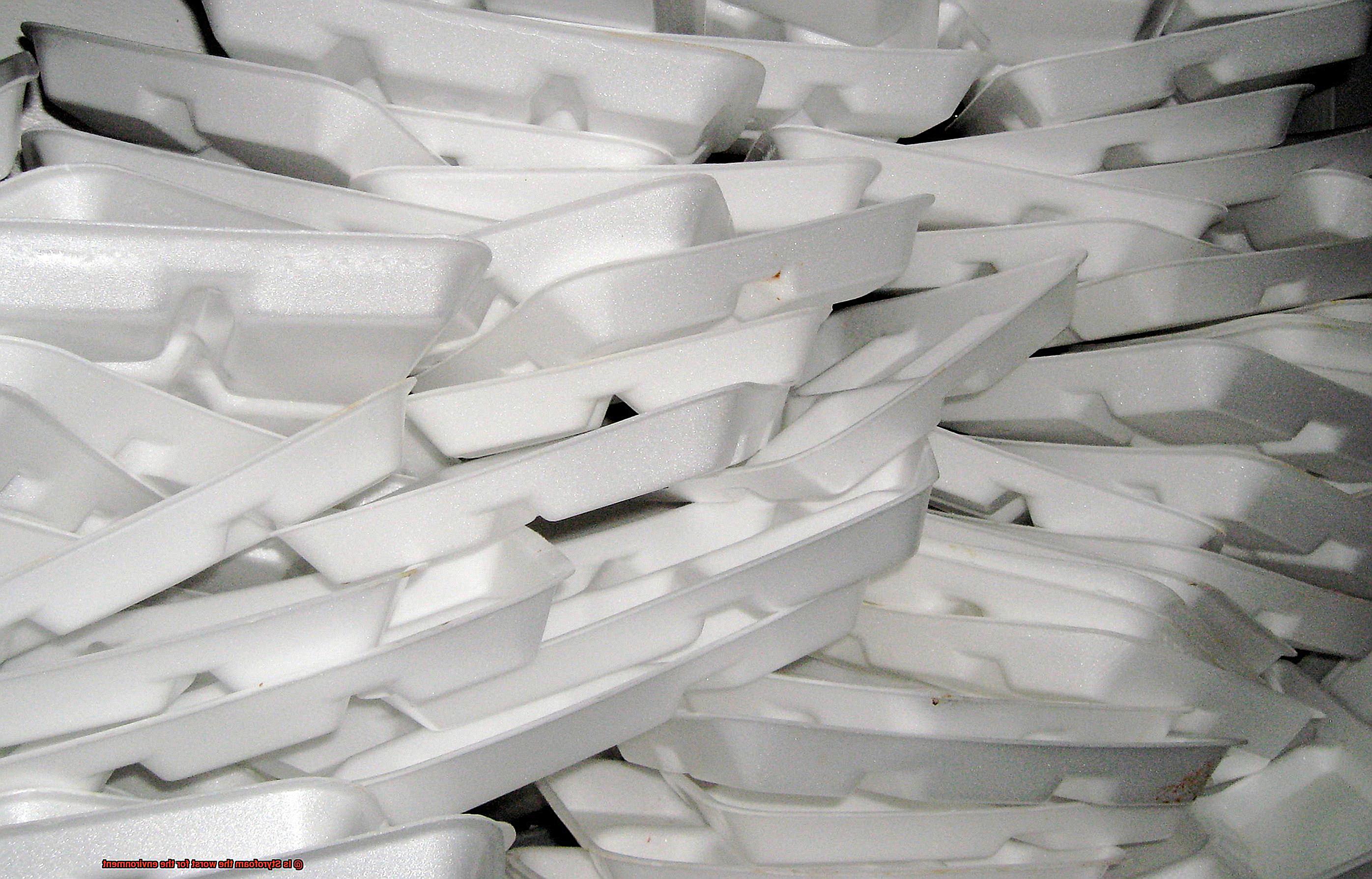
However, there is one critical aspect of Styrofoam that cannot be ignored: its devastating impact on the environment. Styrofoam is not biodegradable and can take hundreds of years to break down in the environment, endangering ecosystems and wildlife in the process.
Thankfully, eco-friendly alternatives are becoming popular choices. By reducing our dependence on harmful materials like Styrofoam and opting for sustainable alternatives like paper-based packaging materials or reusable containers, we can make a significant difference in protecting our planet.
Environmental Impact of Styrofoam
Styrofoam, or Expanded Polystyrene (EPS), is a material that has become ubiquitous in our daily lives. With its lightweight and insulating properties, it’s the perfect packaging material for everything from food to electronics. Unfortunately, Styrofoam’s environmental impact is cause for concern.
Did you know that Styrofoam is not biodegradable? It can take up to 500 years to decompose in landfills, which means that Styrofoam waste can accumulate over time and contribute to environmental pollution. This issue is compounded by the fact that Styrofoam is lightweight and can easily break into small pieces. These small pieces can be harmful to wildlife if ingested. Studies have shown that marine animals such as sea turtles and seabirds mistake Styrofoam for food and ingest it, which can cause blockages in their digestive systems and lead to death.
The production of Styrofoam also has a negative impact on the environment. The process requires the use of fossil fuels such as oil and gas, which contributes to greenhouse gas emissions and climate change. Additionally, the production process generates toxic chemicals that can be harmful to workers and the environment.
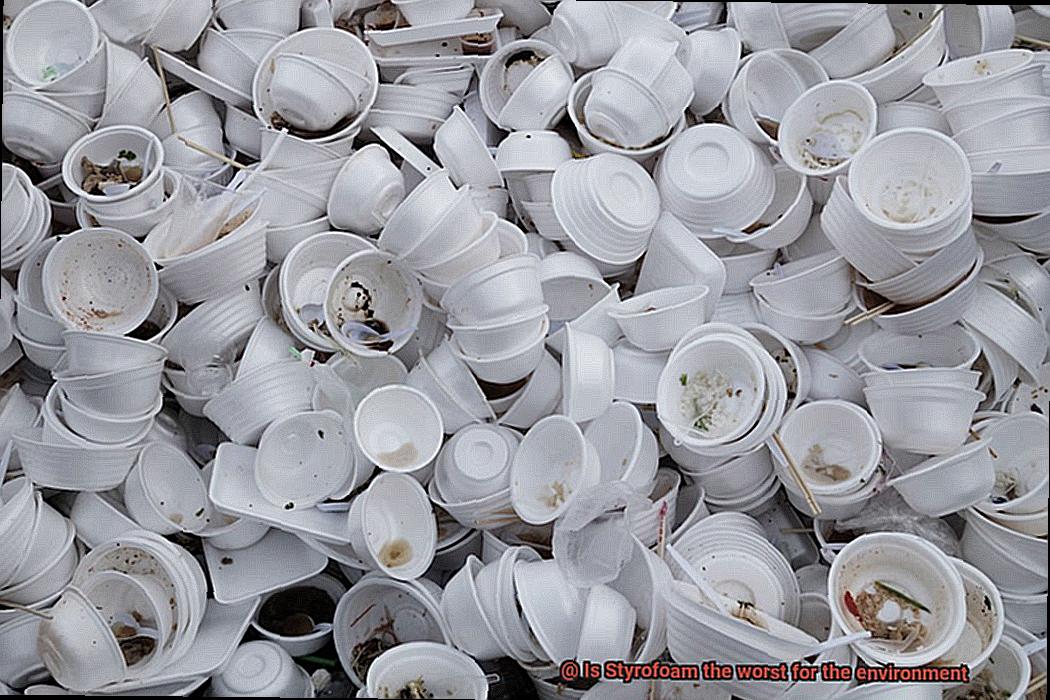
Some companies have started using biodegradable materials such as cornstarch-based packaging as an alternative to Styrofoam. Others have developed new technologies for recycling Styrofoam waste into new products.
Difficulty of Recycling Styrofoam
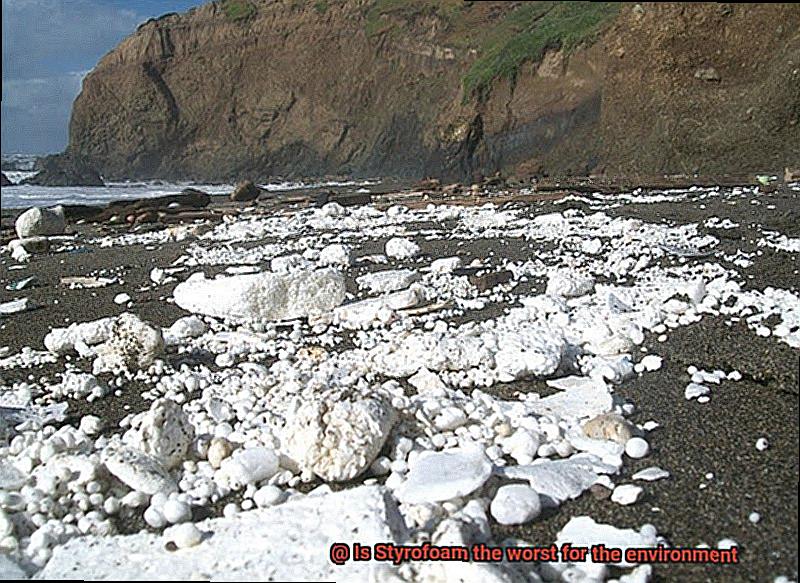
Styrofoam is a popular packaging material that has become increasingly problematic for the environment. This is because it is not biodegradable and can take up to 500 years to decompose in landfills, causing harm to wildlife and ecosystems. Although many companies are now turning to biodegradable alternatives or recycling Styrofoam waste into new products, recycling Styrofoam remains a daunting challenge.
One of the primary reasons why recycling Styrofoam is so difficult is due to its lightweight nature. It breaks apart easily into small pieces that can contaminate other materials in the recycling stream, making it difficult to sort and process. Additionally, Styrofoam consists of 98% air, which means that it takes up a considerable amount of space in landfills.
Another significant challenge is the cost of recycling Styrofoam. The process of melting down and compressing it into blocks, which can then be recycled into other products, requires specialized equipment and is expensive. This makes it economically unviable for many recycling centers.
Even if Styrofoam is recycled successfully, it can only be recycled a limited number of times before it loses its structural integrity and becomes unusable. This means that even when Styrofoam is recycled, it ultimately ends up in a landfill, contributing to environmental pollution.
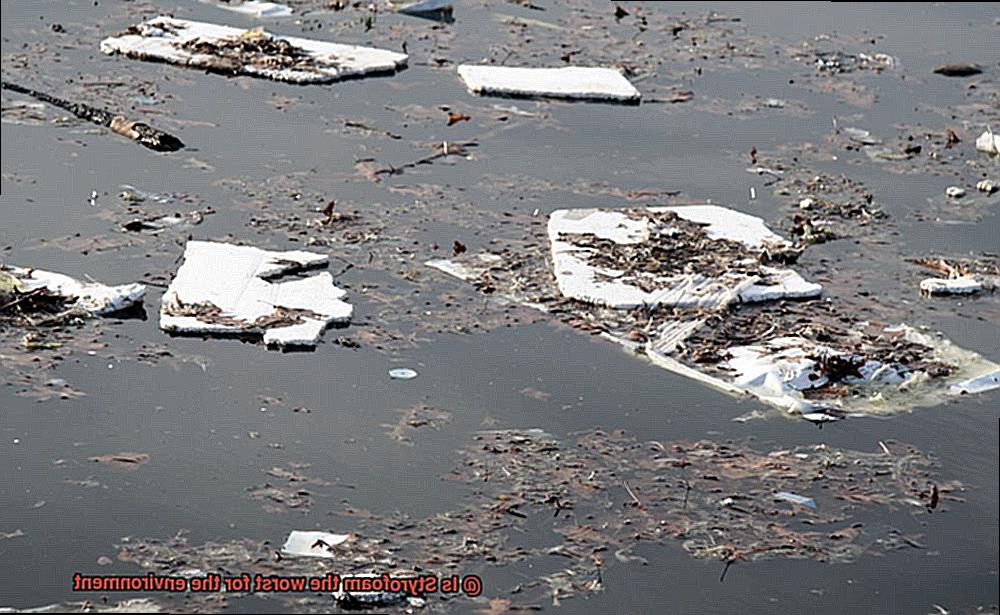
The difficulty of recycling Styrofoam makes it a significant contributor to plastic pollution in our oceans. Every year, over 8 million metric tons of plastic end up in the ocean, with much of it being made up of Styrofoam. This has led to a growing movement to ban or phase out the use of Styrofoam products in favor of more sustainable alternatives.
Production Process of Styrofoam
The production process of Styrofoam starts with polystyrene, a petroleum-based plastic that is derived from fossil fuels. Unfortunately, this plastic requires the use of harmful chemicals such as benzene, styrene, and ethylene, all of which are hazardous to human health and the environment.
Moving on to the first step in creating Styrofoam: polystyrene beads. These tiny beads are then heated and expanded with steam to form the Styrofoam material we all know so well. But did you know that this process requires a significant amount of energy? This energy consumption contributes to greenhouse gas emissions and thus, global warming.
The problem with Styrofoam doesn’t end there. Disposal of this material poses a significant environmental problem as well. Styrofoam is not biodegradable, which means it can take hundreds of years to break down in landfills. Even worse, incinerating Styrofoam releases toxic chemicals into the air, contributing to air pollution.
The production process and disposal of Styrofoam pose significant environmental challenges that must be addressed. For this reason, many cities and countries have implemented bans or restrictions on the use of Styrofoam products. It’s essential to start looking for alternatives to Styrofoam products that are more environmentally friendly, such as paper-based products or biodegradable plastics.
Alternatives to Styrofoam
Styrofoam may have once been the go-to packaging material for its lightweight and insulating properties, but it’s high time to ditch it. Why? Because it’s not biodegradable and can take hundreds of years to decompose in landfills. This means that Styrofoam is a major contributor to environmental pollution and poses a serious threat to wildlife, particularly when it ends up in our oceans and other waterways.
But don’t fret. There are plenty of eco-friendly alternatives to Styrofoam that are both sustainable and effective. For example, biodegradable packing peanuts made from cornstarch or other natural materials offer the same cushioning and protective qualities as Styrofoam without harming the environment. Plus, they dissolve in water.
Molded pulp is another fantastic alternative to Styrofoam, as it’s made from recycled paper and can be used for a variety of packaging purposes. It’s lightweight yet provides excellent protection for even the most fragile items.
When it comes to food packaging, there are also plenty of alternatives to Styrofoam. Bamboo, for instance, is both renewable and biodegradable. It can be used as a replacement for plastic cutlery, plates, and cups. Alternatively, molded fiber made from sugarcane waste or bamboo can be used for takeout containers.
These plant-based materials made from cornstarch break down quickly in a composting environment, making them an excellent alternative to Styrofoam.
rcRjgg5V-nw” >
Conclusion
In conclusion, Styrofoam is undoubtedly one of the biggest environmental threats we face today. Its non-biodegradable nature means it can linger in landfills and oceans for hundreds of years, wreaking havoc on our planet. From plastic pollution to greenhouse gas emissions, Styrofoam has a devastating impact on our environment.
Sustainable options like paper-based packaging or reusable containers are gaining popularity among businesses and individuals alike.
Reducing our use of Styrofoam products is an easy and effective way to protect our planet for future generations. By opting for biodegradable packing peanuts made from cornstarch or other natural materials, molded pulp made from recycled paper, bamboo-based food packaging, or compostable plastics made from plant-based materials like cornstarch, we can help reduce the negative impact of Styrofoam on the environment.
It’s time to say goodbye to Styrofoam and embrace more sustainable alternatives that offer the same protective qualities without harming the environment. Let’s all do our part in creating positive change and protecting our planet from irreversible damage caused by harmful materials like Styrofoam.
